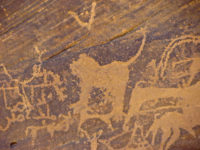Blog Archives
-
Lion
The lion is one of the four large felines, second in size only to the tiger. The male lion has a distinctive mane, and their coats have been very valuable through history. Lions have been associated with persons of high status through the millennia and across the continents. Lion hunting has been a sport of royalty and nobility around the ancient world.
-
Al Sinya, near Al Ula
Sporadic small figures on this rock are sprinkled about its face. It is unusual in having three lions depicted. A chariot with multiple spokes is pulled by two equids and one man is driving it. Camels are also shown, as well as one domestic bull.
-
Eagle’s Nest, Jubbah
This panel of petroglyphs near Jubbah is densely packed with animal and human figures, mainly dating to the Neolithic, but with some more recent ones overlying them.
-
Qaryat al-Asba
This is one of the best known and most visited examples of Saudi Arabian rock art, located not far west of Riyadh. This prominent panel bears a wide diversity of animals and numerous battle scenes.




